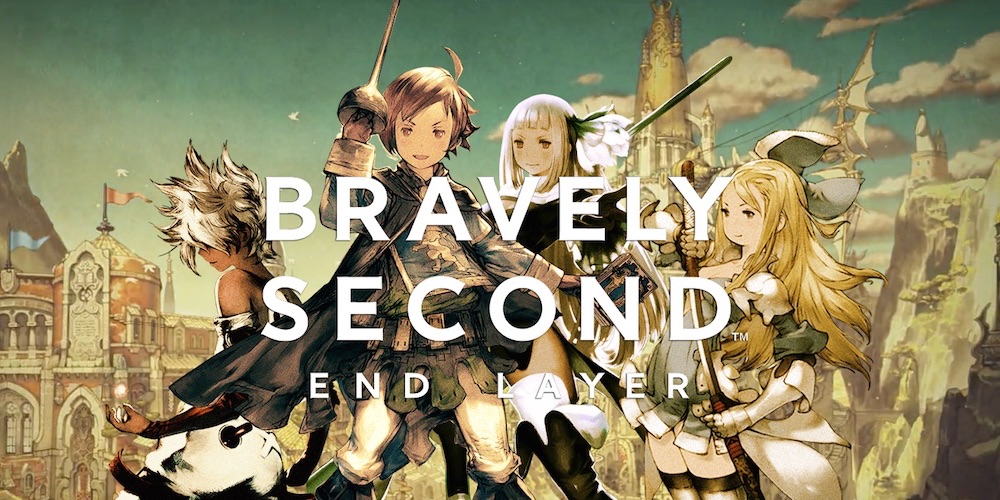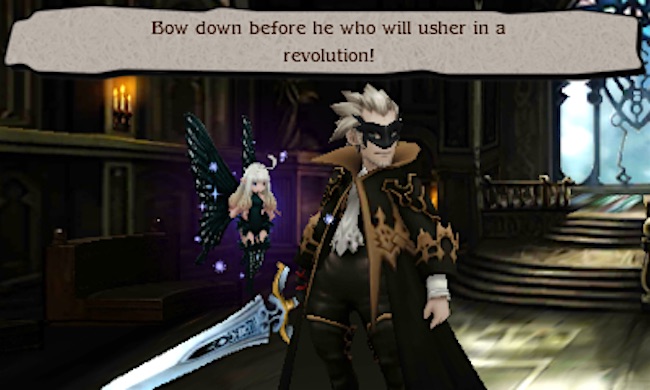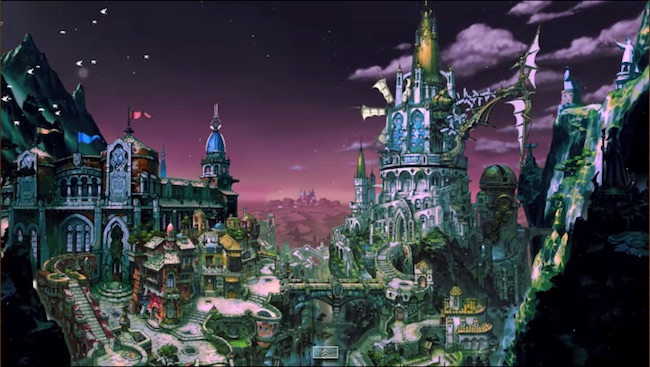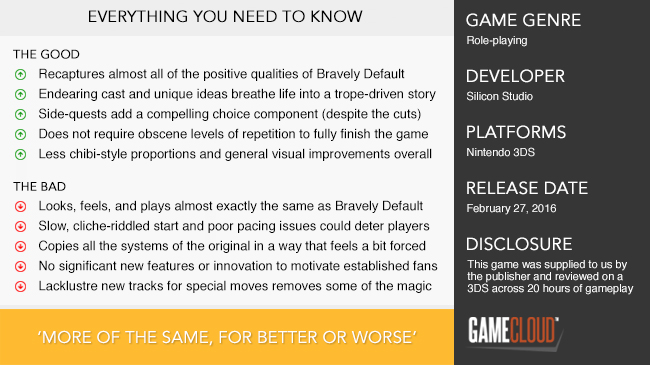
I think it’s fair to say we each have quirks when it comes to what we enjoy in games—and, in saying that, sometimes these preferences can prevent us from enjoying an otherwise totally well-made game. For some players, it may be an exclusive interest in multiplayer, rendering story a total non-interest. For others, it could be that JRPGs or turn-based combat is simply not for them. Personally, I have very broad interests, so I enjoy most genres—story-driven JRPGs especially. There is one thing I really dislike, however, and that’s retreading the same ground. Single-player replayability is not something I desire, though I respect that others do and always consider it in my reviews. Why do I bring this up? Well, Bravely Second (despite plenty of positive qualities) basically looks, feels, and plays the same as its predecessor.

I liked Bravely Default, a lot. You can read my review here if you want, a lot of the same praises apply. However, before I even dig into what Bravely Second is, I can say right now—If you want more of the same, stop here, and go buy it. If you’re not sure, or you’re like me and find things being too similar unappealing—well, keep reading and I’ll lay it all out for you because there are just as many steps backward as there are improvements. To open, though, I’ll start with the premise. It has been two and a half years since we last saw our heroes. It has been a time of peace, and Agnès has just stepped up to become the newly inaugurated Pope of the Crystal Orthodoxy. Naturally, this doesn’t last very long as a new villain (Kaiser Oblivion) appears—defeating the Crystal Guard, kidnapping her, and flying away on his skyship.
Obviously, the plot delves much deeper than than that—it is a JRPG after all. However, I can’t say I’m a big fan of the narrative being driven by what is essentially the same setup as Super Mario Bros., or the fact that Silicon Studios allowed a solid female main character such as Agnès to fall prey to the damsel in distress trope. To be fair, though, the writers (who I should clarify are not the original team) didn’t totally disempower her, as, by communicating through a magic pendant, she is able to replace the role of Aery—both in conversation and on the second screen. It works well enough, just as all the other convenient ways the team found to copy mechanics from the original game do, but I’ll get to that soon enough. In Bravely Second, players will take on the role of Yew Geneolgia, captain of the Three Cavaliers.

Let me first say that I really enjoyed Yew as the new protagonist. He’s caring, passionate, headstrong, and a generally likeable young chap. Essentially, Yew is a better-developed version of the previous lead, Tiz. I admit I didn’t stop to think about Tiz too much, because, as the player character, he served as a vessel for my experiences and did a fine job at that. However, having him return to the main party as his own character, I quickly realised how his personality is overshadowed by the others. He and Yew are just too similar in both appearance and personality—as in, they’re both qualified to fill the cliche of the “good guy.” Of course, there are differences, but I would have preferred someone totally fresh. He also has a really stupid haircut, which I’m almost certain happened to ensure players didn’t confuse the two.
From the beginning, this series set out to recapture and shake up all of the common JRPG tropes, and nothing has changed with Bravely Second. Although, I have to admit I walked away this time feeling as if the series has begun to establish an identity beyond just being a great Final Fantasy game in all but name. Fans will enjoy returning to further explore the land of Luxendarc; however, where the first game had a defined structure and clear player motives, I found the follow-up to have a lingering sense non-urgency—which, in turn, hindered the narrative from being as driving as it should have been. It will come as no surprise that Bravely Second is filled with just as many exciting twists and turns (there are some great meta-themes as previously hinted at too), but it’s still the characters which make this story work.

For all it did right, Bravely Default was heavily criticised for the level of repetition required to unlock its ‘true ending.’ Narratively it was brilliant, but the gameplay definitely started to wear thin by the third or fourth time. I think by the end I ended up investing somewhere in the vicinity of 100 hours. I believe it’s also for this reason why I personally didn’t get into Bravely Second as much as the original as the fundamentals are the same—albeit without that frustrating level of repetition. Outside of the story, you’ll still explore, fight enemies, and build up your levels, jobs, and skill sets enough to defeat a series of bosses. It’s a classic formula, and it works just as well this time while also retaining the brave/default system and the ability to setup auto-battling, adjust the speed of combat, and increase/decrease the encounter rate.
The ability to ‘Bravely Second’ (as per the name of the game) isn’t exactly new—like most things. In fact, it was the most controversial feature in its predecessor where players build up special points (SP) for every 8 hours your 3DS is in standby or with micro-transactions. It’s the same here. You can use these points to freeze time and attack at any time, which is still cool, but hardly innovative like with the brave/default system. Honestly, the only notable gameplay innovation I noticed was the ability to stack consecutive battles for an XP multiplier. I liked this as it added a new layer to the auto-battling—which, in itself is a unique type of play; not to be mistaken for the game being able to play itself automatically. I’ll say this about the Bravely series, when it counts, the game ensures a need for planning and strategy.

As I mentioned earlier, the Silicon Studios found a way to pretty much bring back every main feature from Bravely Default. Yew likes to keep a journal (albeit it doesn’t predict the future like with Ringabell’s), Agnes replaces Aery on the second screen with the ‘Ask Agnes’ system, and Magnolia (the ‘Ba’al busting,’ English/French speaking ‘Lunarian,’ and newcomer to the party) has you rebuilding her city on the Moon (just roll with it) in a F2P-style meta-game just like with Tiz’s village in the original. It all works fine, although it definitely doesn’t feel very fresh. What makes a comeback with improvements, however, are side-quests where you must pursue sub-characters to resolve an issue and earn a unique job asterisk. The difference this time is that you are put in the middle of a dispute and forced to choose a side.
Once again, these side-quests have no bearing on the main plot (although, it’s less obvious this time around). How it works is that there are two asterisk available per quest, but you can only obtain one depending on who you side with. These scenarios are also cleverly used to bring back a lot of familiar faces, which I think fans will enjoy. Implementing choice was an effective way to add more weight to the proceedings, and they only get more involved the further you progress into the story. Despite how well this approach is implemented, though, it’s also a big point of controversy. To cut a long story short, there was some ‘censorship’ (or cuts, as I prefer) that included some sexualised outfits as well as the negative outcomes in these quests–effectively ensuring Westerners receive a positive outcome no matter what.

Naturally, you can expect to see new jobs, abilities and specials, as well as a new mini-game called ‘Chompcraft’—where you make stuffed toys to unlock items. For me personally, these additions still weren’t enough to stomp out the feeling of “been there, done that.” Usually a decent story will push me through, but the sense of non-urgency this time around eventually brought my interest to a halt. I simply wasn’t willing to invest any more time after 20 hours; except through let’s plays and online research. Direct sequels need to evolve to remain engaging, which is why, despite their problems, I think games such as Final Fantasy X-2 got it right by changing up the framework and mechanics. Bravely Second is well-crafted game, no doubt, but I can’t deny I’d rather do something fresh—even if it doesn’t work as well.
If there are any improvements to take away, it’s that Silicon Studios somehow made one of the best looking games on the 3DS look even better. Personally, I liked the choice to make the characters a little less ‘chibi’ in appearance, but everything about the world is slightly more defined and visually interesting. As I mentioned earlier, I feel the game has begun to develop a strong sense of identity, and that’s definitely in part to its many artistic qualities. On the other hand, it’s glaringly obvious the music in Bravely Second was not composed by Revo. That’s not to say it’s bad—newcomer Ryo does a good enough job in most places—but one thing I just couldn’t look past was how lacklustre the music is during the special moves. These tracks were such a critical part of the original’s gameplay, and they are sorely missed.

Objectively speaking, Bravely Second: End Layer is a well-crafted, quality JRPG. It’s also basically the same game as Bravely Default, for better or worse. There are new jobs, abilities and specials, a new mini-game, and all the strongest components of the original make a comeback—which, for some, will sound enticing. The quality of this game is not in dispute, and the gameplay is as excellent as ever. However, it’s certainly not as good as Bravely Default either as the premise is weak beyond a play on tropes and it suffers from pacing issues that can become a hindrance. That’s not to say there aren’t improvements, though. The visuals are better, the side-quests run deeper, and the reduced level of repetition was appreciated. Essentially, whether you’ll enjoy Bravely Second will depend on whether you’re okay with more of the same. For me, after 100+ hours with the original, I needed something more to call me back to Luxendarc.











